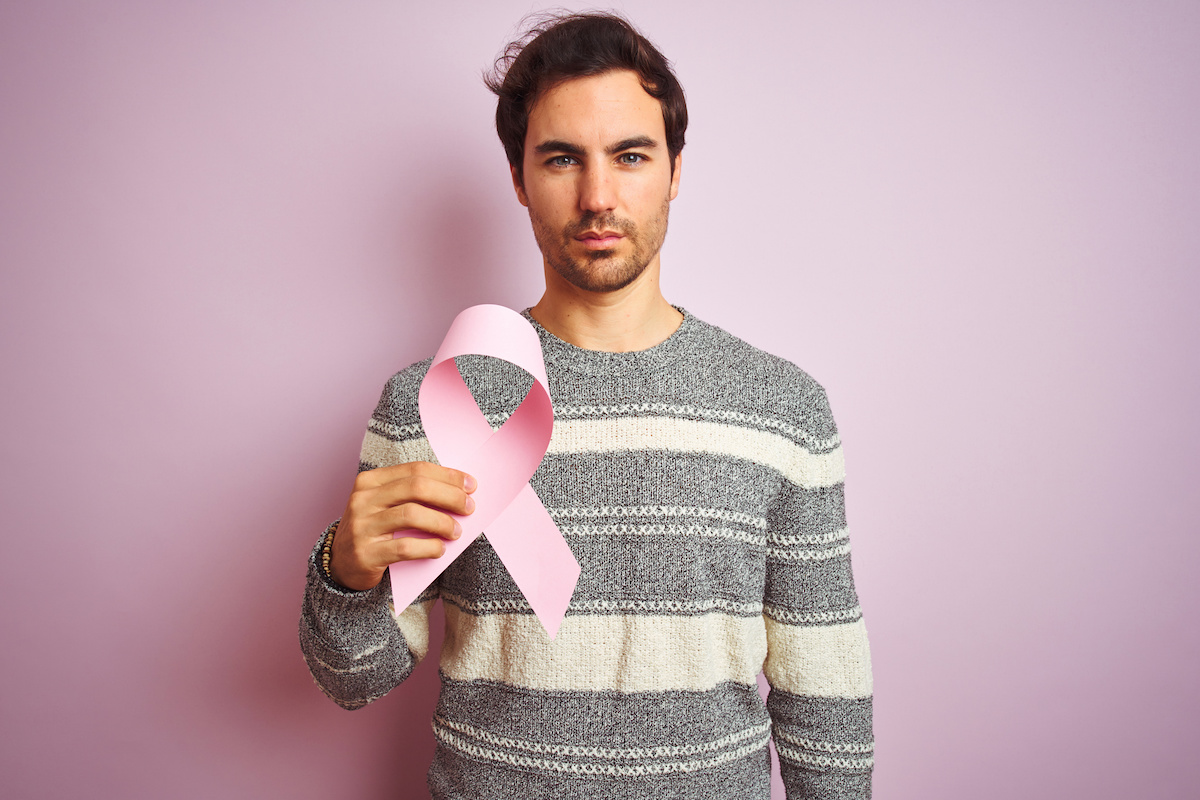Masculinity, Emasculation, and Breast Cancer in Men
Once committed though to a “breast cancer is emasculating” mantra, some health sociologists and patients have come up with a wordplay workaround.

For some reason news stories on sex-associated cancers are most common in the months of September, October, and November. This may be because September is officially Prostate Cancer Month. October is Breast Cancer Month. And November is the month when the Movember Foundation encourages men to grow moustaches to raise awareness of men’s health issues, in particular prostate and testicular cancer.
Last October, there was a flood of stories about breast cancer. However, what was unusual this time around was the attention given to stories about breast cancer in men. This coverage was driven by a variety of factors, but two stand out. The first is that Beyoncé’s father has breast cancer and that provided a journalistic hook for stories about the challenges men face with that disease. The New York Times, CNN and many other media outlets jumped on the bandwagon.
A second hook, which bridged the three months, was the realization that many of the same genetic mutations that are indicative of aggressive breast cancer are also indicative of aggressive prostate cancer. The best known is a mutation of the BRCA2 gene and sadly Beyoncé’s father has that mutation. But it is not really new news that prostate cancer and breast cancer have genetic similarities. That was covered, for example, by Gail Risbridger and colleagues back in 2010 in a major review aptly titled “Breast and Prostate Cancer: More Similar than Different.”1
What was new this year was the heavy promotion of genetic screening. As we learn more about the genetics of cancer, we are developing targeted therapies appropriate for specific genetic profiles. These targeted therapies though are most likely to be effective if initiated when the disease is in an early stage. Sadly, for male breast cancer patients the disease is too often diagnosed at a late stage when curative treatments are no longer available.
This gets us back to the problem of breast cancer in men. Men are more often diagnosed with breast cancer later than women and have poorer survival statistics as a result… even though they are far less likely to get the disease in the first place.
Men’s attitude toward breast cancer has led to a number of studies by health sociologists, who are concerned about the fact that men take poorer care of themselves than woman do.2 Men go to the doctor less often, and when it comes to signs of breast cancer, they often wait too long to book a medical consultation. There have been a smattering of studies of male breast cancer patients by health sociologists, who have tried to understand why men react the way they do to signs of abnormalities in their chest walls.
Much of this research is predicated on the belief that men are socialized to minimize physical discomfort and ignore signs of illness. To sociologists sensitive to gender differences, this is seen as a problem in gender enculturation that needs to be addressed. Several allude to the idea that men are influenced by “hegemonic masculine” ideals. The researchers, who write within that framework, envision a breast cancer diagnosis for a male as emasculating, since having breasts is a female trait. However, having breast cancer is not female-specific since males get breast cancer even if they have no noticeable gynecomastia (breast development).
How men react to gynecomastia and also to developing breast cancer varies greatly,3 and their perspective on what the organs (breasts) and the disease (cancer) mean to their male identity need not be the same. Depending on who you read, a diagnosis of breast cancer is emasculating for males… or maybe not. The literature is inconsistent4 and part of the problem is a lack of rigor in defining masculinity in the first place. Secondary to that is a problem in defining emasculation.
To some sociologists the acquisition of any female dominant trait is emasculating; in that mindset, “feminization means emasculation.” But the data do not show that to be a consistent perspective for the patients, since men can get cancer in vestigial mammary tissue without overt signs of breast development. A study of how prostate cancer patients understand the impact of that disease on their manhood shows that, for that cancer at least, it is loss of male sexual function more than anything else that they find emasculating.5 And, even when the drugs they take cause some breast development, that is not consistently described as “emasculation.”
Once committed though to a “breast cancer is emasculating” mantra, some health sociologists and patients have come up with a wordplay workaround. That is to relabel the disease as “chest cancer.” As an anatomist I find that imprecise and unappealing. Furthermore, there are no data showing that such rebranding of the disease in any way reduces distress from the cancer diagnosis.
Breast cancer begins as a disease of the superficial anterior thoracic wall, which may invade the chest deep to the rib cage, but it doesn’t start there. The American College of Chest Physicians have been publishing the journal Chest since 1935. Chest deals overwhelmingly with cardiovascular and pulmonary diseases, including the “chest” cancer that kills the most men, namely lung cancer.

When articles on breast cancer appear in Chest they commonly deal with the metastatic spread of the disease into the chest. So, for example, whereas Chest’s search engine comes up with 91,500 references to the “heart” and “lung,” it flags only 310 papers in Chest that mention the “breast.” Notably, none of those papers is specific to early stage breast cancer. Most instead deal with the metastatic spread of the disease deeper into the thorax.
It has proven unhelpful to presume that the lower survival for men with breast cancer than women is due to men being socialized into a gender hierarchy that is disdainful of females. Even if adherence to hegemonic masculinity is a factor for why men are inattentive to palpable anomalies on their torso, it is frankly silly to assume that it can be solved by renaming a dangerous disease so as to distance it from females.
There is one fact though that should make men more aware of, and attentive to, signs of breast cancer. That is a comparison with testicular disease. Because of Lance Armstrong and organizations like Movember, testicular cancer has had a lot of media exposure. And, admittedly, it is more common than male breast cancer. But both cancers are, in fact, quite uncommon, and testicular cancer is easier to treat.
The American Cancer Society estimates that for this calendar year some 400 USA men will die of testicular disease. By comparison approximately 500 men will die of breast cancer. Similar differences show up in Canadian and Australian statistics, with 25 – 40 percent more men dying each year of breast cancer than testicular cancer.
If men are willing to learn how to examine their testes for lumps, bumps, and irregularities, they surely can learn how to do the same for their chest wall. But we need to get the word out about this.
The Movember Foundation closed out the 2019 “sex-associated cancer season” with their slogan “Changing the face of men’s health” followed in big font by “Prostate cancer, testicular cancer, mental health, and suicide prevention—we’re taking them all on.” The question in my mind is, “What will it take for Movember and men in general to put breast cancer on the list of men’s diseases?”
References:
1 Risbridger, GP, ID Davis, SN Birrell, WD Tilley 2010 Breast and Prostate Cancer: More Similar than Different. Nature Reviews Cancer, 10(3): 205-212.
2 Tsang, V, RJ Wassersug 2018 Men’s Health Research versus Andrology—Defining the Division and Closing the Divide. Journal of Men’s Health, 14(3): e20-e32.
3 Wassersug, RJ, JL Oliffe 2009 The Social Context for Psychological Distress from Iatrogenic Gynecomastia with Suggestions for its Management. Journal of Sexual Medicine, 6(4): 989-1000.
4 Quincey, K, I Williamson, S Winstanley 2015 ‘Marginalised Malignancies’: A Qualitative Synthesis of Men’s Accounts of Living with Breast Cancer. Social Science & Medicine, 149: 17-25.
da Silva, TL 2016 Male Breast Cancer: Medical and Psychological Management in Comparison to Female Breast Cancer. A Review. Cancer Treatment Communications, 7: 23-34.
Skop, M, J Lorentz, M Jassi, D Vesprini, G Einstein 2018 “Guys Don’t Have Breasts”: The Lived Experience of Men who have BRCA Gene Mutations and Are at Risk for Male Breast Cancer. American Journal of Men’s Health, 12(4): 961-972.
Thompson, EH, AS Haydock 2019 Men’s Lived Experiences with Breast Cancer: The Double Consciousness of Marginal Men. Sex Roles, 82: 28–43.
Krumm, S, C Checchia, M Koesters, R Kilian, T Becker 2017 Men’s Views on Depression: A Systematic Review and Metasynthesis of Qualitative Research. Psychopathology, 50:107-124.
Rabbee, Z, S Grogan 2016 Young Men’s Understandings of Male Breast Cancer: “Pink Ribbons” and “War Wounds.” International Journal of Men’s Health, 15 (3): 210-217.
5 Tsang, VWL, C Skead, C, RJ Wassersug, JL Palmer-Hague, 2019 Impact of Prostate Cancer Treatments on Men’s Understanding of Their Masculinity. Psychology of Men & Masculinities, 20(2): 214–225.












